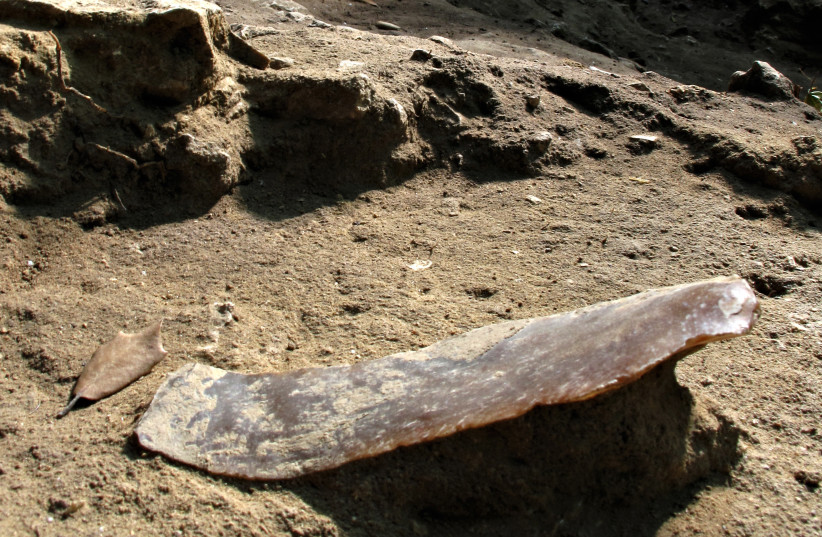The discovery of a child’s tooth layered between Neanderthal remains in a cave in southern France is the earliest evidence of modern humans in Europe, confirming that both hominins lived there at the same time.
As reported on February 9 in the journal Science Advances, finds from the Mandrin cave – including most strikingly the tooth from a modern human child age two to six – document the first alternating occupation of a cave between modern humans and Neanderthals and other early humans.
The tooth, the only early human tooth found, was sandwiched between archaeological layers containing Neanderthal teeth belonging to at least six other individuals and other remains. Researchers say this indicates that Neanderthals had inhabited the cave before and after the human child lived there over the last millennia of Neanderthals’ existence.
“We must keep in mind that after 150 years of archaeology, we found a total of six teeth, including our Mandrin tooth from the period of the first sapiens for all of continental Europe from 54,000 to 39,000 years ago,” said Ludovic Slimak, a cultural anthropologist at the French National Center for Scientific Research and the University of Toulouse’s Jean Jaurès, who co-led the research and has spent 30 years excavating the Mandrin rock shelter. “We are dealing with very rare and highly precious data.”
The research was co-led by Clément Zanolli, a paleoanthropologist at the University of Bordeaux.

Based on the analyses of soot deposits on the vault fragments of the cave roof, the researchers were also able to conclude that modern humans lived in the shelter for about 40 years before mysteriously disappearing, and that Neanderthals moved back into the cave not more than a year after they left.
The discoveries are significant, say the researchers, because determining the extent of overlap between modern humans and other hominins in Eurasia – such as Neanderthals and Denisovans – is fundamental to understanding the nature of their interactions and what led to the disappearance of the archaic hominins.
“The results from Grotte Mandrin presented here show that instead of recording a single event of population replacement as often argued elsewhere in Europe, a much more complex process of modern human appearance and Neanderthal disappearance appears to have occurred in Western Europe,” the researchers wrote. “We document at least four alternating phases of replacement.”
Conjecturing if the two groups may have had any interactions at the Mandrin cave area, Slimak noted that by analysis of flint tools it was determined that the territories of both Neanderthals and homo sapiens were quite large, about 100 kilometers in all directions around the cave and compromised the same territory. It also appears that the early homo sapiens immediately knew which raw material sources to use. Therefore, he said, it is quite possible that the Neanderthals transmitted their knowledge to the new arrivals.
“They may have had Neanderthal scouts among them to guide them for example,” he said. “Such configuration however is a classic, or even a universal situation in ethnography. This is precisely what happened when Europeans began the colonization of the Americas or Australia.”

The researchers determined that the modern human population occupied this Rhône territory for some 40 years, which represents a full generation, said Slimak.
“THESE ARCHAEOLOGICAL records do not correspond to some sort of short-term hunter-gatherer camp, but reveal a true tentative colonization of Europe by a pretty numerous group,” he said, adding that the wealth of remains including thousands of artifacts, tools, weapons, remains of hunted animals and fireplaces at the site could correspond to a group of at least some tens or even hundreds of persons who migrated with long-term intentions.
He said that this was “definitively not a short occupation of the cave by isolated individuals,” and that the modern human tooth belonging to a young child indicates that this group was clearly composed of men, women, and children, and definitely not only some male hunters who set out to explore this territory of Western Europe.
The modern human remains from the cave were dated to 56,800 and 51,700 years ago. Researchers believe the incursion was by groups that had major technical advantages over the contemporaneous Neanderthal group 10,000 years before the earliest known modern human sites in Europe, which are located in Bulgaria and southern Italy.
Apart from a possible sporadic incursion recorded in Greece during the Middle Pleistocene, the first settlement of modern humans in Europe has been constrained to about 45,000 to 43,000 years ago, the researchers wrote.
More modern human fossils and tools associated with the Neronian lithic industry, which consists of lighter spear points that can be mounted on projectile weapons, were also found among the layers containing Neanderthal remains associated with the heavier tools and weapons of the Mousterian industries.
Until now, the Neronian lithic industry had not been documented anywhere else as early as at Mandrin, and it was unknown who made them. But with the human tooth layered together with the Neronian lithic tools, the researchers believe they have been able to link the two together.
“This early modern human incursion in the Rhône Valley is associated with technologies unknown in any industry of that age outside of Africa or the Levant,” the researchers wrote.
Slimak noted that the Neronian traditions are remarkably modern with mass production, standardization, precise tiny points – some less than 10 mm. in maximum length. They are also exactly the same technologies found in the eastern Mediterranean region at the very beginning of the Upper Paleolithic in the same chronology as the Mandrin cave, he said.
“These technologies are deeply divergent with Neanderthal technologies before and after the modern human settlements in the cave,” Slimak said.
However, these finds are “a strict technical and cultural replication” of homo sapien finds of the Initial Upper Paleolithic known from the eastern coast of the Mediterranean sea as found in Ksar Akil in Lebanon.
Since there is 3,000 km. (approx. 1,800 miles) between the middle Rhône Valley and Mount Lebanon, early homo sapiens likely came by sea along trans-Mediterranean routes, said Slimak. The Rhône is one the most important rivers of Europe, the second-most important Mediterranean river after the Nile, and the only natural path from the Mediterranean coast up into continental Europe, he noted.
“We are dealing here with a major historical process that occurred in one of the most important geographical areas of Europe in terms of natural migrations,” said Slimak.
Interestingly, he said the colonization of Australia occurred precisely at the very same time period between 50,000 and 60,000 years ago.
“We then know that when Mandrin groups reached Western Europe, Eurasian populations had perfectly mastered navigation at the other end of the continent,” said Slimak. “It is very likely that these navigation technologies were at this time well-known by all of these Eurasian modern populations. The synchrony between these two events, at the two ends of Eurasia, is certainly a key point in the understanding of these early sapiens’ expansions.”
